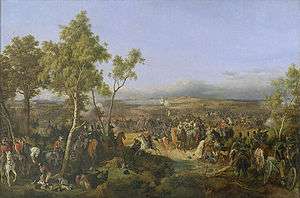Battle of Tarutino
| Battle of Tarutino | |||||||
|---|---|---|---|---|---|---|---|
| Part of French invasion of Russia (1812) | |||||||
 Battle of Tarutino, by Piter von Hess | |||||||
| |||||||
| Belligerents | |||||||
|
|
| ||||||
| Commanders and leaders | |||||||
| Count Levin August von Bennigsen | King Joachim Murat | ||||||
| Strength | |||||||
|
36,000; 13,000 actually participated in the battle. | 26,000 | ||||||
| Casualties and losses | |||||||
| 1,200 |
2,500 dead, 2,000 captured, 38 cannon lost | ||||||
The Battle of Tarutino (Russian: Тарутинo) was a part of Napoleon's invasion of Russia. The battle is sometimes called the Battle of Vinkovo or the Battle of Chernishnya after the local river. Many historians claim that the latter name is more fitting because the village of Tarutino was 8 km from the described events. In the battle Russian troops under the command of Bennigsen defeated French troops under the command of Joachim Murat.
Preceding events
After the battle of Borodino, Kutuzov realized that the Russian army would not survive one more large engagement and ordered the army to leave Moscow and retreat. At first it retreated in the south-east direction along the Ryazanskaya road. When the army reached the Moskva it crossed it and turned to the west to the Old Kaluzhskaya road. The army pitched camp in a village of Tarutino near Kaluga. At the same time small units of Cossacks continued moving along the Ryazanskaya road misleading French troops under the command of Murat. When he discovered his error he did not retreat but made camp not far from Tarutino in order to keep his eye on the Russian camp.
The battle
On 18 October 1812 Kutuzov ordered Bennigsen and Miloradovich to attack Murat's corps (26,000 men) with two columns stealthily crossing the forest in the dead of night. Bennigsen's main column included three columns led by Vasily Orlov-Denisov, Karl Gustav von Baggehufwudt and Alexander Osterman-Tolstoy respectively. The other column was supposed to play an auxiliary role. In the darkness most of the troops got lost. By the morning only Cossack troops under the command of General Vasily Orlov-Denisov reached the original destination, suddenly attacked the French troops and captured the French camp with transports and cannons. Since other Russian units came late the French were able to recover. When the Russians emerged from the forest they came under French fire and suffered casualties (among others the commander of the 2nd Corps, General Baggehufwudt, was killed [1]). Murat was forced to retreat to escape being surrounded. The French forces suffered 2,500 dead and 2,000 prisoners, the Russians lost 1,200 dead. The defeat infuriated Napoleon, who felt the retreat following the loss would appear to the world as though he had been defeated. As a result, he moved the army south in a final attempt to engage and defeat the Russian main army, but the clash at the Battle of Maloyaroslavets ended with the Russians withdrawing again, and the forces under his command no longer had the horses to overtake Kutuzov and force the issue.[2]
The total number of cannon captured by the Russians at Tarutino -- 38 pieces in all -- was noteworthy because until this point in the war, neither side had lost nearly as many guns in a single encounter. This was regarded by the Russian rank-and-file as a sign that the tide of the war was finally turning in their favor.
The battle of Tarutino is depicted in Leo Tolstoy's War and Peace. Tolstoy, who frequently argued throughout the novel that an individual cannot change history or manage historical processes, described the battle as nothing but a chain of accidents and coincidences.
References
- ↑ Genealogy Handbook of Baltic Nobility
- ↑ Caulaincourt p. 171
- От Тарутино до Малоярославца (к 190-летию Малоярославецкого сражения [From Tarutino to Maloyaroslavets (on the 190th anniversary of the Battle of Maloyaroslavets)]. Kaluga, Zolotaya Alleya, 2002.
Coordinates: 55°10′38″N 37°00′10″E / 55.17722°N 37.00278°E